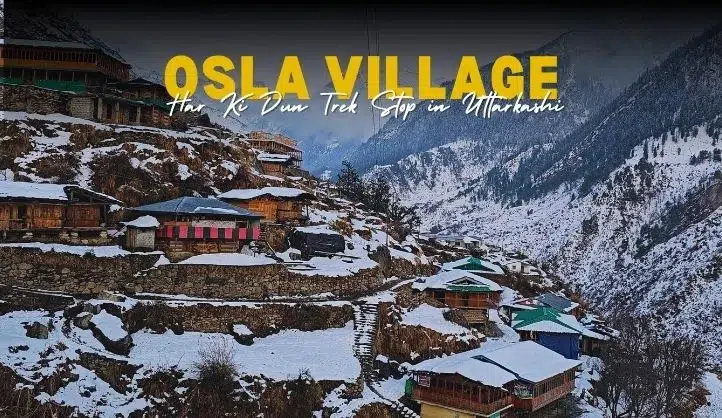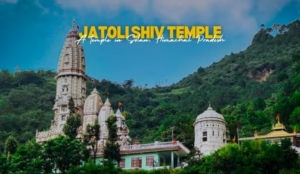Nestled amidst the majestic peaks of the Garhwal Himalayas, in the quaint town of Gopeshwar, Uttarakhand stands the Gopinath Temple. Dedicated to Lord Shiva, this ancient shrine reverberates with devotees’ chants and the mountains’ serene whispers. More than just a place of worship, the Gopinath Temple is a testament to the region’s rich history, architectural brilliance, and unwavering spiritual heritage.
A Legacy Steeped in Mystery and Myth
The exact origins of the Gopinath Temple remain shrouded in the mists of time. While historical estimates place its construction between the 9th and 11th centuries, local legends weave a more captivating narrative. One popular tale suggests that the temple finds its name in Lord Krishna’s association with Gopeshwar. It is believed that Lord Krishna, enchanted by the sound of Shiva’s cosmic dance, attempted to enter the divine gathering. However, the gatekeeper, unaware of Krishna’s true identity, denied him entry. Pleased by Krishna’s devotion, Shiva himself is said to have manifested in Gopeshwar, forever linking the place to Krishna (Gopi) and the divine (Peshawar).
Another legend attributes the temple’s construction to King Saggar. However, concrete evidence points towards a much older origin. The inscriptions found on the colossal trident in the temple courtyard date back to the 12th century, hinting at a pre-existing structure. Further credence to this theory comes from the fragmentary remains of idols scattered around the temple complex, suggesting the presence of additional shrines in bygone eras.
How to reach the temple
By Air
The nearest airport to Gopeshwar is Jolly Grant Airport in Dehradun, located about 258 km away. From there, you can hire a taxi or cab to reach Gopeshwar
By Train
The nearest railway station to Gopeshwar is Rishikesh Railway Station, located about 220 km away. From there, you can hire a taxi or cab to reach Gopeshwar.
By Road
- From Delhi to Gopeshwar the total distance is about 435 km and it should take 10 to 12 hours.
- From Haridwar to Gopeshwar the distance is about 227 km and the travel time is about 7 hours.
- From Rishikesh to Gopeshwar the distance is about 207 km and the travel time is about 6.5 hours.
A Winter Abode for Rudranath
The significance of the Gopinath Temple extends beyond its spiritual stature. During the harsh winter months, when the high-altitude shrine of Rudranath becomes inaccessible due to heavy snowfall, the Gopinath Temple serves as its winter abode. The revered idol of Rudranath, one of the Panch Kedars (five holy Shiva temples of Uttarakhand), is housed within the Gopinath Temple during this period. This unique practice allows devotees to continue their pilgrimage and seek blessings from Rudranath throughout the year.
Architectural Splendor
The Gopinath Temple is a magnificent example of the architectural prowess of the region. Built in the Nagara style, the temple boasts a towering central dome that dominates the skyline. The sanctum sanctorum, a square chamber measuring around 30 square feet, is unique. Unlike most Shiva temples with a single entrance, the Gopinath sanctum has a total of 24 doors, symbolizing the omnipresence of the divine. The intricate carvings adorning the doorway depict various deities and celestial beings, adding a layer of visual enchantment to the temple’s aura.
The temple courtyard houses a colossal trident (trishul) that stands at an impressive height of 5 meters. Crafted from eight different metals, this awe-inspiring structure is believed to date back to the 12th century. Inscriptions attributed to King Ashokchalla of Nepal, who reigned in the 13th century, further enhance the historical significance of this monument. Legend has it that the trident marks the spot where Lord Shiva, in his wrath, pierced Kamadeva, the God of Love, with his celestial weapon. The fact that the metal remains unmarred by the elements adds an air of mystique to the legend.
Within the sanctum sanctorum lies the revered Shivalinga, known as Gopinath. This self-manifested (Swayambhu) form of Shiva is worshipped in its unique Mridh Roop (form) – a combination of Lord Shiva’s Ekan (face) and Lord Vishnu’s Mridh (clay). This unique representation signifies the harmonious coexistence of the two principal deities in Hinduism.
A Pilgrimage Destination and a Spiritual Sanctuary
The Gopinath Temple attracts throngs of devotees throughout the year. The holy festival of Shivratri witnesses a surge in pilgrims who come to offer prayers and participate in the elaborate rituals. The serene atmosphere of the temple, accentuated by the rhythmic chanting of hymns and the tinkling of bells, provides solace and a sense of deep spiritual connection. For many, a visit to the Gopinath Temple is not just a pilgrimage, but a transformative experience.
Exploring Gopeshwar
Gopeshwar, the town that houses the temple, offers a charming glimpse into the life of the Garhwal region. Narrow, winding lanes lined with traditional shops selling religious artifacts and local handicrafts lead to the temple complex. For those seeking a deeper cultural immersion, exploring the nearby villages provides opportunities to interact with the warm and welcoming residents. The breathtaking natural beauty surrounding Gopeshwar
Adventures in the Garhwal Himalayas
For the more adventurous soul, Gopeshwar serves as a base for exploring a range of trekking routes. The trek to Kedarnath, one of the holiest Shiva shrines in India, is a popular option. The challenging yet rewarding journey offers stunning panoramic views of the Himalayas and a chance to experience the rich spiritual heritage of the region. For those seeking a less strenuous experience, shorter treks to nearby waterfalls and meadows provide opportunities to appreciate the natural wonders of the Garhwal.
A Culinary Delights
No exploration of a place is complete without indulging in its local cuisine. Gopeshwar offers a delightful array of vegetarian dishes, reflecting the traditional Garhwali fare. Freshly prepared staples like mandra (made from finger millet flour), aloo gutke (potato curry), and bhang ki chutney (made from cannabis leaves) are a must-try. For those with a sweet tooth, local delicacies like bal mithai (made from lentils) and jhangore ki kheer (made from foxtail millet) offer a unique and delicious experience.
Festivals and Celebrations
Gopeshwar comes alive during various festivals throughout the year. Makar Sankranti, a harvest festival celebrated in January, is a vibrant occasion marked by bonfires, traditional dances, and community gatherings. Another noteworthy festival is Vishu Sankranti, which falls in April and celebrates the beginning of the new year according to the solar calendar. This festival features colorful processions, religious ceremonies, and a festive atmosphere. Participating in these local celebrations allows visitors to gain a deeper understanding of the customs and traditions that define the Garhwali way of life.
Nearby Places to Explore
Rudranath Temple
During the winter months, when the high-altitude shrine of Rudranath becomes inaccessible due to heavy snowfall, the Gopinath Temple serves as its winter abode. The revered idol of Rudranath, one of the Panch Kedars (five holy Shiva temples of Uttarakhand), is housed within the Gopinath Temple during this period.
Kalpeshwar Temple
Located around 58 km from Gopeshwar, Kalpeshwar Temple is another abode of Lord Shiva. Dedicated to the destroyer of darkness, this temple is believed to have been built by the Pandavas during their exile. The scenic beauty surrounding the temple and the serenity of the place make it a popular pilgrimage destination.
Sagar Village
Sagar village, located around 5 km from Gopeshwar, serves as the starting point for the trek to Rudranath. This quaint village offers a glimpse into the rural life of the Garhwal region. The verdant meadows and snow-capped mountains surrounding the village create a picture-perfect backdrop.
Chopta
Located approximately 38 km from Gopeshwar, Chopta is often referred to as the “Mini Switzerland of India” due to its stunning meadows surrounded by snow-capped peaks. It serves as the base camp for treks to Tungnath, the highest Shiva temple in the world, and Chandrashila, offering mesmerizing views of the Himalayas.
Tungnath Temple
Situated around 41 km from Gopeshwar, Tungnath Temple is one of the Panch Kedar temples dedicated to Lord Shiva. Nestled at an altitude of 3,680 meters, it is the highest temple of Lord Shiva in the Garhwal region and is known for its spiritual significance and panoramic vistas.
Ansuya Devi Temple
Located approximately 18 km from Gopeshwar, Ansuya Devi Temple is a revered Hindu shrine dedicated to Mata Ansuya, the mother of Lord Dattatreya. The temple is perched on a hilltop and offers panoramic views of the surrounding mountains and valleys. It is believed that worshipping at this temple fulfills devotees’ wishes and brings prosperity.
Conclusion
The Gopinath Temple stands as a testament to the enduring legacy of faith and devotion in the Garhwal Himalayas. Its intricate architecture, captivating legends, and spiritual significance make it a pilgrimage destination that transcends religious boundaries. Gopeshwar, the town that embraces the temple, offers a captivating blend of nature’s splendor, cultural richness, and warm hospitality. Whether seeking spiritual solace, an adventurous escapade, or simply a chance to reconnect with nature, the Gopinath Temple and its environs offer an unforgettable experience, leaving visitors with a profound sense of peace and a renewed appreciation for the wonders of the Himalayas.
5 FAQs about Gopinath Temple
1. What is the significance of the Gopinath Temple?
The Gopinath Temple is dedicated to Lord Shiva and is renowned for several reasons:
- Winter Abode of Rudranath – During winter, when the high-altitude Rudranath Temple becomes inaccessible, the Gopinath Temple houses the revered idol of Rudranath.
- Unique Architecture – The temple features a magnificent central dome and a sanctum sanctorum with an unusual 24 doors, symbolizing the omnipresence of the divine.
- Swayambhu Shivalinga – The Gopinath Shivalinga is a self-manifested form (Swayambhu) and is worshipped in its unique Mridh Roop, a combination of Lord Shiva’s face and Lord Vishnu’s clay form.
2. What are some interesting features of the Gopinath Temple complex?
- Colossal Trishul – A massive trident (trishul) made of eight metals stands tall in the courtyard, dating back to the 12th century. Inscriptions attributed to King Ashokchalla of Nepal add to its historical significance. Legend suggests it marks the spot where Lord Shiva pierced Kamadeva with his weapon.
- Mythological Connection – Local legends associate the temple’s name with Lord Krishna (Gopi) and the divine (eshwar). One story suggests Krishna’s attempt to enter Shiva’s celestial dance resulted in the temple’s creation.
3. When is the best time to visit the Gopinath Temple?
The temple is open year-round, but there are peak seasons to consider:
- Shivratri – This Hindu festival witnesses a surge in pilgrims who come to offer prayers and participate in elaborate rituals.
- Summer (April to June) – Pleasant weather makes for a comfortable exploration of the temple and surrounding areas.
- Winter (November to February)- While the high-altitude Rudranath is inaccessible, this period allows you to experience the unique practice of housing the Rudranath idol at Gopinath Temple.
4. What are some activities to do near the Gopinath Temple?
Gopeshwar offers various activities besides visiting the temple:
- Explore nearby villages – Immerse yourself in the local way of life through interactions with the Garhwali people and exploring their villages like Chaurabari, Madaur, or Khunti.
- Embrace nature – Hike to waterfalls like Sari Village Waterfall or Nanda Devi Waterfall, or spend time amidst the vibrant wildflowers in Bugyal Meadows.
- Trekking adventures – For the adventurous, Gopeshwar serves as a base for treks like the challenging yet rewarding journey to Kedarnath or shorter hikes to nearby meadows.
5. How to reach the Gopinath Temple?
Gopeshwar is well-connected by road to major cities in Uttarakhand. Taxis or cabs are readily available from nearby railway stations (Rishikesh) or airports (Jolly Grant Airport, Dehradun).









